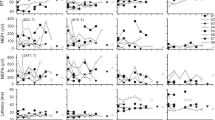Abstract
Objective
To determine if task performance and fatigability during rapid repetitive exercise of the lower limb differ in a group of MS subjects compared to a control group, and what central changes accompany the development of fatigue and the period of recovery.
Methods
Transcranial magnetic stimulation (TMS) was used to compare motor evoked potential (MEP) responses between 10 clinically definite MS subjects (7F, 33– 64 years of age; EDSS ≤ 4; MRC grade ≥ 4/5) and 13 control subjects during and after 5 bouts of a 15-second maximum rate foot-tapping task performed at 1 minute intervals.
Results
Maximum voluntary contraction (MVC) force of ankle dorsiflexion was lower (15 %) in the MS group compared to controls; however there were no differences in the rate of foot tapping. The rate of foot tapping decreased during each bout of exercise to a comparable degree in both groups, but there was no overall deterioration in performance across the 5 repeat bouts in either group. MS subjects showed a greater decline in strength than controls after exercise (20.7 ± 7.7 % vs. 6 ± 3.6 %; p < 0.05). MEP amplitude increased significantly for the exercised limb in both groups, but the increase was greater in MS subjects (65.9 ± 27 % vs. 31 ± 19.6 %; MS vs. control; p < 0.05). MEP amplitude also increased for the non-exercised limb in controls (40.6 ± 15.6 %, p < 0.01) but not in MS subjects.
Conclusions
Mild to moderately affected MS subjects can perform a fatiguing exercise requiring a high level of central motor control but this is associated with a greater strength loss and increase in corticomotor excitability compared to unaffected individuals.
Significance
Central adaptive processes are likely to have a significant role in maintaining task performance in MS.
Similar content being viewed by others
References
Benwell NM, Mastaglia FL, Thickbroom GW (2006) Reduced functional activation after fatiguing exercise is not confined to primary motor areas. Exp Brain Res 175:575–583
Bonato C, Zanette G, Manganotti P, Tinazzi M, Bongiovanni G, Polo A, Fiaschi A (1996) ‘Direct’ and ‘crossed’ modulation of human motor cortex excitability following exercise. Neurosci Lett 216:97–100
Gean-Marton AD, Vezina LG, Marton KI, Stimac GK, Peyster RG, Taveras JM, Davis KR (1991) Abnormal corpus callosum: a sensitive and specific indicator of multiple sclerosis. Radiology 180:215–221
Humphry AT, Lloyd-Davies EJ, Teare RJ, Williams KE, Strutton PH, Davey NJ (2004) Specificity and functional impact of post-exercise depression of cortically evoked motor potentials in man. Eur J Applied Physiol 92:211–218
Kent-Braun JA, Sharma KR, Weiner MW, Miller RG (1994) Effects of exercise on muscle activation and metabolism in multiple sclerosis. Muscle & Nerve 17:1162–1169
Lazarski JP, Ridding MC, Miles TS (2002) Dexterity is not affected by fatigue-induced depression of human motor cortex excitability. Neurosci Lett 321:69–72
Nielsen JF, Norgaard P (2002) Increased post-exercise facilitation of motor evoked potentials in multiple sclerosis. Clin Neurophysiol 113: 1295–1300
Perretti A, Balbi P, Orefice G, Trojano L, Marcantonio L, Brescia-Morra V, Ascione S, Manganelli F, Conte G, Santoro L (2004) Post-exercise facilitation and depression of motor evoked potentials to transcranial magnetic stimulation: a study in multiple sclerosis. Clin Neurophysiol 115:2128–2133
Petajan JH, White AT (2000) Motorevoked potentials in response to fatiguing grip exercise in multiple sclerosis patients. Clin Neurophysiol 111:2188–2195
Polman CH, Reingold SC, Edan G, Filippi M, Hartung HP, Kappos L, Lublin FD, Metz LM, McFarland HF, O’Connor PW, Sandberg-Wollheim M, Thompson AJ, Weinshenker BG, Wolinsky JS (2005) Diagnostic criteria for multiple sclerosis: 2005 revisions to the “McDonald Criteria”. Ann Neurol 58:840–846
Samii A, Canos M, Ikoma K, Wassermann EM, Hallett M (1997) Absence of facilitation or depression of motor evoked potentials after contralateral homologous muscle activation. Electroencephalogr Clin Neurophysiol 105:241–245
Schmierer K, Irlbacher K, Grosse P, Roricht S, Meyer B-U (2002) Correlates of disability in multiple sclerosis detected by transcranial magnetic stimulation. Neurology 59:1218–1224
Schubert M, Wohlfarth K, Rollnik JD, Dengler R (1998) Walking and fatigue in multiple sclerosis: the role of the corticospinal system. Muscle & Nerve 21:1068–1070
Sheean GL, Murray NM, Rothwell JC, Miller DH, Thompson AJ (1997) An electrophysiological study of the mechanism of fatigue in multiple sclerosis. Brain 120(Pt 2):299–315
Thickbroom GW, Byrnes ML, Archer SA, Kermode A, Mastaglia FL (2005) Corticomotor organisation and motor function in multiple sclerosis. J Neurol 252:765–771
Thickbroom GW, Sacco P, Kermode AG, Archer SA, Byrnes ML, Guilfoyle A, Mastaglia FL (2006) Central motor drive and perception of effort during fatigue in multiple sclerosis. J Neurol 253:1048–1053
Zijdewind I, Kernell D (2001) Bilateral interactions during contractions of intrinsic hand muscles. J Neurophysiol 85:1907–1913
Author information
Authors and Affiliations
Corresponding author
Rights and permissions
About this article
Cite this article
Thickbroom, G.W., Sacco, P., Faulkner, D.L. et al. Enhanced corticomotor excitability with dynamic fatiguing exercise of the lower limb in multiple sclerosis. J Neurol 255, 1001–1005 (2008). https://doi.org/10.1007/s00415-008-0818-6
Received:
Revised:
Accepted:
Published:
Issue Date:
DOI: https://doi.org/10.1007/s00415-008-0818-6




